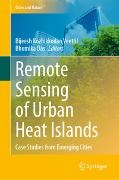Read more
As urbanization intensifies, the phenomenon of urban heat islands poses significant challenges to public health, energy consumption, and overall urban livability. The integration of remote sensing technology into urban heat island (UHI) research offers powerful tools for precise, scalable, and real-time monitoring. Remote Sensing of Urban Heat Island: Innovations, Strategies, and Future Directions provides an in-depth exploration of the intersection between remote sensing technology and the study of the UHI effect.
Starting with a foundational understanding of urban heat islands, the book delves into the causes and consequences of UHIs, emphasizing their significance in the context of urbanization and climate change. It then transitions into a detailed overview of remote sensing principles, technologies, and methodologies, providing readers with the technical knowledge needed to understand and utilize these tools effectively.
A significant portion of the book explores various remote sensing techniques specifically tailored for UHI studies, including thermal remote sensing, land use and land cover (LULC) analysis, and the use of spectral indices. These sections are enriched with real-world applications and case studies from major and emerging cities around the globe, demonstrating how remote sensing data can inform urban planning and policymaking to create more sustainable and resilient urban environments. The book also addresses the public health and environmental implications of UHIs, linking remote sensing data with broader socio-economic and environmental indicators. It highlights practical mitigation strategies that can be implemented based on remote sensing insights, providing a bridge between scientific research and actionable urban planning solutions. Contributions discuss emerging technologies and methodologies in the field, as well as potential advancements that could further enhance our understanding and management of urban heat islands. This forward-looking perspective ensures that readers are not only equipped with current knowledge but are also prepared for future developments in remote sensing and UHI research.
Written in an accessible style that balances technical detail with readability, this book serves as a comprehensive guide for anyone interested in the applications of remote sensing technology in urban environments and the ongoing efforts to address the challenges posed by urban heat islands.
List of contents
Understanding Urban Heat Islands: Definition, Causes and Effects.- Historical perspective: Urban Heat Islands (UHIs) research and its significance.- Technologies and Instruments: Satellites and sensors for urban heat island research.- Thermal Remote Sensing: A Case Study on Detecting and Analysing Surface Temperature Variations in Response to Land Use and Land Cover Changes.- Land Use Land Cover Analysis: Understanding the Relationship between Urban Development and Urban Heat Islands.- Assessing the Impact of LULC on Land Surface Temperature Variations Using GIS and Remote Sensing.- Global Trends in Urban Heat Island Research Using Remote Sensing: A Scientometrics Analysis.- Vegetation degradation, urban sprawl, and land surface temperature variations in the Dalat City, Vietnam.- Role of Artificial Intelligence (AI) in Urban Heat Island Research.- Policy Implications of Integrating Remote Sensing Data into Urban Policy and Planning.

